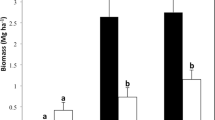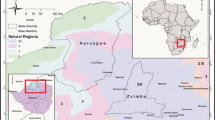Abstract
This study was carried out to investigate if on-farm cut vs. grazed pastures differed in soil fertility and species density in the temperate Himalayan highlands. Soil fertility and species relative density were measured from 30 cut and 30 grazed dairy pastures. In both types of pasture, soil pH, available phosphorus (P) and exchangeable potassium (K) were negatively correlated with pasture age and slope. In cut pasture, cocksfoot (Dactylis glomerata) and pasture age were positively correlated, whereas in grazed pasture, they were negatively correlated. In grazed pasture, unsown species and pasture age were positively correlated. Soil available P was significantly greater in cut pastures whereas soil exchangeable K was significantly greater in grazed pastures. In terms of species density, cut pasture had greater densities of cocksfoot and Italian ryegrass (Lolium multiflorum), whereas grazed pasture showed greater densities of white clover, sedge and local grass. Our study suggests that, if there are no improvements in the current method of pasture management, the cut pastures in the future are likely to have a simple pasture mixture constituting only cocksfoot and white clover (Trifolium repens). Whereas in grazed pasture, the pasture mixture is likely to be comprised of white clover and unsown species such as sedge, local grass and broadleaf weeds.
Similar content being viewed by others
References
Ball D, Everest J (2013) Suppression of broom sedge in pastures. Miscellaneous Forage Publications. Department of Agronomy and Soils, College of Agriculture, Auburn University, Auburn, AL, USA
Belesky DP, Fedders JM, Ruckle JM, et al. (2002) Bermuda grass-white clover-bluegrass sward production and botanical dynamics. Agronomy Journal 94: 575–584.
Brady NC (1995) The nature and properties of soil. Prentice hall of India private limited, New Delhi, India.
Bray RH, Kurtz LT (1945) Determination of total, organic, and available forms of phosphorus in soils. Soil Science 59: 39–45.
Brereton AJ, Carton OT, Conway A (1985) The effect of grass tiller density on the performance of white clover. In: Proceedings of the XVth 381 International Grassland Congress, Kyoto, Japan. pp 756–757.
Brock JL, Hay MJM (2001) White clover performance in sown pastures: A biological/ecological perspective. Proceedings of the New Zealand Grassland Association 63: 73–83.
Caradus JR, Williams WM (1989) Breeding for legume persistence in New Zealand. In: Persistence of forage legumes (Eds Martin GC, Matches AG, Barnes RF, Brougham RW, Clements RJ, Sheath GW) American Society of Agronomy, Madison, Wisconsin, USA. pp 523–539.
Cayley JWD, McCaskill MR, Kearney GA (2002) Available phosphorus, sulphur, potassium, and other cations in a longterm grazing experiment in south-western Australia. Australian Journal of Agricultural Research 53: 1349–1360.
Condron LM, Goh KM (1990) Implications of long term superphosphate applications on the accumulation and plant availability of soil phosphorus under irrigated pastures. In: Proceedings of the New Zealand Grassland Association 1990, Ashburton, New Zealand.
Davies A (2001) Competition between grasses and legumes in established pastures. In: Competition and succession in pastures (Eds Tow PG, Lazenby A), CABI Publishing. pp 63–82.
Diaz S, Acosta A, Cabido M (1994) Grazing and the phenology of flowering and fruiting in a montane grassland in Argentina: a niche approach. Oikos 70: 287–295.
Diaz S, Cabido M, Zak M, et al. (1999) Plant functional traits, ecosystem structure and land use history along a climatic gradient in central–western Argentinia. Journal of Vegetation Science 10: 651–660.
FAO-AGL (2000) ProSoil–Problem soils database, land and plant nutrition management service. Available online at: http://www.fao.org/ag/agl/agll/prosoil/calc.htm (Accessed on 10 June 2013).
FAO-UNESCO (1974) Soil map of the world. Volume 1 legend. UNESCO, Paris, France.
Friend DA, Dolan PL, Hurst AM (2001) Superphosphate boosts productivity and profitability of native grass pastures in Tasmania. In: Proceedings of the Australian Agronomy conference. Australian Society of Agronomy, Tasmania.
Gourley CJP, Mwlland AR, Waller RA et al. (2007) Making better fertilizer decisions for grazed pastures in Australia. Department of Primary Industries Melbourne, Victoria, Australia.
Grant SA (1981) Sward Components. In: Sward measurement handbook (Eds Hodgson J, Baker RD, Davies A, et al.), British Grassland Society. pp 71–91.
Harris SL, Clark DA (1996) Effect of high rates of nitrogen fertilizer on white clover growth, morphology, and nitrogen fixation activity in grazed dairy pasture in northern New Zealand. New Zealand Journal of Agricultural Research 39: 149–158.
Hiernaux P, Bielderst CL, Valentin C, et al. (1999) Effects of livestock grazing on physical and chemical properties of sandy soils in Sahelian rangelands. Journal of Arid Environment 41: 231–245.
Jewell PL, Kauferle D, Gusewell S, et al. (2007) Redistribution of phosphorus by cattle on a traditional mountain pasture in the Alps. Agriculture, Ecosystems and Environment 122: 377–386.
Karsten HD, Fick GW (1999) White clover growth patterns during the grazing season in a rotationally grazed dairy pasture. Grass and Forage Science 54: 174–183.
Kemp DR, King WM (2001) Competition and succession in pastures. CABI Publishing, New York, USA.
Koenig R, Nelson M, Barnhill J, Miner D (2002) Fertilizer management for grass and grass-legume mixtures. Available online at: https://extension.usu.edu/files/publications/publication/AG-FG-_03.pdf (Accessed on 29 December 2015)
Korte CJ, Parsons AJ (1984) Persistence of large leaved white clover variety under sheep grazing. In: Proceedings of the New Zealand Grassland Association. pp 118–123.
Lambert MG, Mackay AD, Costall DA (1998) Long term fertilizer application and fertility of hill soils. In: Proceedings of the New Zealand Grassland Association. pp 63–67.
Lambert MG, Clark DA, Mackay AD, Costall DA (2000) Effects of fertilizer application on nutrient status and organic matter content of hill soils. New Zealand Journal of Agricultural Research 43: 127–138.
Landau S, Everitt BS (2004) A handbook of statistical analysis using SPSS. Chapman & Hall/CRC, CRC Press Company, New York, USA.
Lemaire G, Chapman D (1996) Tissue flows in grazed communities. In: Ecology and Management of Grazing Systems (Ed Hodgson JAI), CAB International, Wallingford, Oxon, UK. pp 3–38.
Lemus R, Weirich J (2010) Making pasture weed control decisions. Available online at: http://msucares.com/crops/forages/newsletters/10/3.pdf (Accessed on 21 June 2013)
Lopez IF, Lambert M G, Mackay A D, Valentine I (2003) The influence of topography and pasture management on soil characteristics and herbage accumulation in hill pasture in the North Island of New Zealand. Plant and Soil 255: 421–434.
Leps J, Smilauer P (2003) Multivariate analysis of ecological data using CANOCO. Cambridge University Press, New York, USA.
Mackay AD, Lambert MG, Barker DJ (1999) Effect of intensification of livestock farming on the physical properties of a hill soil. In: Best soil management practices for production (Eds Currie LD, Hedley MJ, Horne DJ, Loganathan P), Fertilizer and Lime Research Centre, Massey University, Palmerston North, New Zealand. pp 311–315.
Macklon AES, Mackie-Dawson LA, Sim A, et al. (1994) Soil P resources, plant growth and rooting characteristics in nutrient poor upland grasslands. Plant and Soil 163: 257–266.
Marriott CA, Bolton GR, Fisher JM (2003) Changes in species composition of abandoned sown swards after imposing seasonal cutting treatments. Grass and Forage Science 58: 37–49.
McCartney DH, Bittman S, Nuttall WF (2004) The Influence of Harvest Management and Fertilizer Application on Seasonal Yield, Crude Protein Concentration and N Offtake of Grasses in Northeast Saskatchewan. Canadian Journal of Plant Science 84: 205–212.
McNaughton SJ, Banyikwa FF, McNaughton MM (1997) Promotion of the cycling of diet–enhancing nutrients by African grazers. Science 278: 1798–1800.
Mitchell KJ, Glenday AC (1958) The tiller population of pastures. New Zealand Journal of Agricultural Research 3: 3050–318.
MoA (1994) Dzongkhag data sheets for Bumthang. Ministry of Agriculture, Thimphu, Bhutan.
Moe SR, Wegge P (2008) Effects of deposition of deer dung on nutrient redistribution and on soil and plant nutrients on intensively grazed grasslands in lowland Nepal. Ecological Research 23: 227–234.
Nevens EF, Reheul ED (2003) Effects of cutting or grazing grass swards on herbage yield, nitrogen uptake and residual soil nitrate at different levels of N fertilization. Grass and Forage Science 58: 431–449.
Pande TN, Yamamoto H (2006) Cattle treading effects on plant growth and soil stability in the mountain grassland of Japan. Land Degradation and Development 17: 419–428.
Pavlu V, Schellberg J, Hejcman M (2011) Cutting frequency vs. N application: effect of a 20-year management in Lolio–Cynosuretum grassland. Grass and Forage Science 66: 501–515.
Peyraud JL, Le Gall A, Luscher A (2009) Potential food production from forage legume-based systems in Europe: an overview. Irish Journal of Agricultural and Food Research 48: 115–135.
Pontes LS, Carrere P, Andueza D, et al. (2007) Seasonal productivity and nutritive value of temperate grasses found in semi–natural pastures in Europe: responses to cutting frequency and N supply. Grass and Forage Science 62: 485–496.
Ritchie ME, Tilman D, Knops JK (1998) Herbivore effects on plant and nitrogen dynamics in oak savanna. Ecology 79: 165–177.
Roder W, Thinley P, Wangdi K (1997) Experiences with temperate mixtures–review. In: Proceedings of the Second Annual National Livestock Research Workshop. RNRRC Jakar, Bathpalathang, Bhutan. pp 69–78.
Roder W, Wangdi K, Gyamtsho P, et al. (2001) Feeding the Herds: Improving Fodder Resources in Bhutan. ICIMOD, Kathmandu, Nepal.
Samdup T, Udo HMJ, Eilers CHAM, et al. (2010) Crossbreeding and intensification of smallholder crop-cattle farming systems in Bhutan. Livestock Science 132: 126–134.
Sanderson MA, Elwinger GF (2002) Plant density and environment effects on orchard grass-white clover mixtures. Crop Science 42: 2055–2063.
Schneider N, Undersander D (2008) Italian ryegrass as a companion for alfalfa seeding. Focus on Forage: 1–3.
SPAL (2004) Soil analysis methods, Ministry of Agriculture, Simtokha, Thimphu, Bhutan.
Tillman R, Officer S (2000) Factors controlling potassium fertility in hill country pastures. Better Crops International 14: 26–28.
Wangchuk K (2005) Species composition of improved dairy pastures in Bumthang, Bhutan. MSc thesis, The University of Melbourne, Victoria, Australia.
Wangchuk K, Roder W, Gyeltshen T (2007) In search of suitable pasture mixtures for temperate Bhutan. RNR Journal of Bhutan 2: 33–39.
Wangchuk K, Lepcha I, Wangda P (2008) Forage production: A handbook for feed and fodder development worker in Bhutan (2nd edition). RNRRC and NFFDP, Bumthang, Thimphu, Bhutan.
Wangchuk K, Dorji K (2009) Factors influencing species composition of improved temperate pastures grazed by dairy cattle. RNR Journal of Bhutan 5: 94–104.
White RE (2006) Maintenance of soil productivity. In: Principles and practices of soil science: The soil as a natural resource (Ed White RE), Blackwell Publishing, Victoria, Australia, p 234–262.
Xie Y, Wittig R (2004) The impact of grazing intensity on soil characteristics of Stipa grandis and Stipa bungeana steppe in northern China (autonomous region of Ningxia). Acta Oecologia 25: 197–204.
Zarekia S, Jafari M, Arzani H, et al. (2012) Grazing effects on some of the physical and chemical properties of soil. World Applied Science Journal 20: 205–212.
Author information
Authors and Affiliations
Corresponding author
Additional information
http://orcid.org/0000-0002-5582-4862
Rights and permissions
About this article
Cite this article
Wangchuk, K. Lowland pasture in Himalayan highland: edaphic properties and species composition. J. Mt. Sci. 13, 455–464 (2016). https://doi.org/10.1007/s11629-015-3544-4
Received:
Accepted:
Published:
Issue Date:
DOI: https://doi.org/10.1007/s11629-015-3544-4




